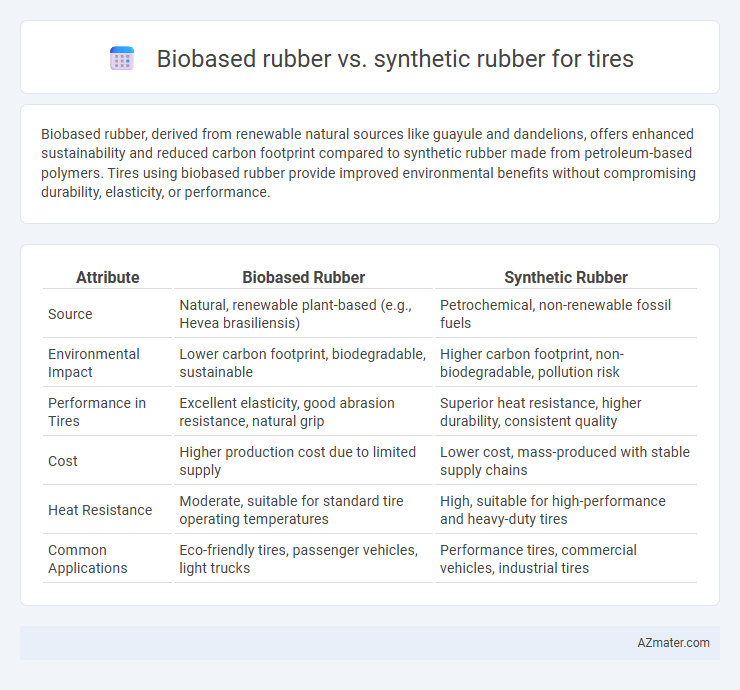Biobased rubber, derived from renewable natural sources like guayule and dandelions, offers enhanced sustainability and reduced carbon footprint compared to synthetic rubber made from petroleum-based polymers. Tires using biobased rubber provide improved environmental benefits without compromising durability, elasticity, or performance.
Table of Comparison
| Attribute | Biobased Rubber | Synthetic Rubber |
|---|---|---|
| Source | Natural, renewable plant-based (e.g., Hevea brasiliensis) | Petrochemical, non-renewable fossil fuels |
| Environmental Impact | Lower carbon footprint, biodegradable, sustainable | Higher carbon footprint, non-biodegradable, pollution risk |
| Performance in Tires | Excellent elasticity, good abrasion resistance, natural grip | Superior heat resistance, higher durability, consistent quality |
| Cost | Higher production cost due to limited supply | Lower cost, mass-produced with stable supply chains |
| Heat Resistance | Moderate, suitable for standard tire operating temperatures | High, suitable for high-performance and heavy-duty tires |
| Common Applications | Eco-friendly tires, passenger vehicles, light trucks | Performance tires, commercial vehicles, industrial tires |
Introduction to Biobased and Synthetic Rubber
Biobased rubber, derived from natural sources such as the rubber tree (Hevea brasiliensis), offers renewable and eco-friendly alternatives to conventional synthetic rubber made from petrochemical polymers like styrene-butadiene rubber (SBR) and polybutadiene. Synthetic rubber provides consistent quality, enhanced durability, and superior performance under varied environmental conditions, making it the dominant material in tire manufacturing. Advances in biobased rubber technologies focus on improving elasticity, wear resistance, and sustainability metrics to compete with the established capabilities of synthetic rubber in tire applications.
Key Differences in Raw Materials
Biobased rubber is derived from natural sources such as the latex of rubber trees (Hevea brasiliensis) and other plant-based materials, offering renewable and sustainable raw inputs. Synthetic rubber, in contrast, is produced from petrochemical derivatives like styrene and butadiene, relying heavily on non-renewable fossil fuels. The primary difference lies in biobased rubber's natural origin versus synthetic rubber's chemical synthesis from fossil-based monomers, impacting environmental sustainability and material properties for tire manufacturing.
Environmental Impact Comparison
Biobased rubber significantly reduces carbon footprint by utilizing renewable natural resources, leading to lower greenhouse gas emissions compared to synthetic rubber derived from petroleum. The biodegradability of biobased rubber minimizes long-term environmental pollution, whereas synthetic rubber contributes to persistent microplastic contamination in ecosystems. Lifecycle assessments highlight that biobased rubber tires offer a more sustainable alternative by decreasing reliance on fossil fuels and promoting circular economy principles.
Performance Characteristics in Tire Applications
Biobased rubber offers enhanced environmental benefits with comparable elasticity and abrasion resistance to synthetic rubber in tire applications. Synthetic rubber, primarily composed of styrene-butadiene and polybutadiene, provides superior wear resistance and heat aging stability, crucial for high-performance and long-lasting tires. The choice between biobased and synthetic rubber impacts tire rolling resistance, traction, and durability, influencing overall vehicle fuel efficiency and safety.
Durability and Longevity Analysis
Biobased rubber offers enhanced environmental benefits but generally exhibits lower durability and shorter longevity compared to synthetic rubber in tire applications. Synthetic rubber, formulated from petroleum-based compounds like styrene-butadiene and polybutadiene, provides superior abrasion resistance, tensile strength, and aging properties, leading to longer-lasting tire performance. Advances in biobased rubber technology aim to improve wear resistance and oxidative stability, yet synthetic rubber remains the industry standard for high-durability, long-life tires.
Cost Considerations: Biobased vs Synthetic Rubber
Biobased rubber typically incurs higher production costs than synthetic rubber due to raw material sourcing and limited large-scale manufacturing infrastructure. Synthetic rubber benefits from established petrochemical supply chains and economies of scale, resulting in lower and more stable prices for tire manufacturing. Cost volatility in crude oil prices can impact synthetic rubber pricing, whereas biobased rubber prices depend heavily on agricultural commodity markets and seasonal yields.
Sustainability and Renewable Resources
Biobased rubber, derived from natural sources such as Hevea brasiliensis, offers enhanced sustainability by utilizing renewable resources that reduce dependence on fossil fuels compared to synthetic rubber made from petrochemicals. This renewable nature of biobased rubber supports lower carbon emissions and better biodegradability, crucial for eco-friendly tire manufacturing. Incorporating biobased rubber in tires promotes circular economy principles, contributing to reduced environmental impact and long-term resource conservation in the automotive industry.
Market Trends and Consumer Demand
Biobased rubber is gaining traction in the tire industry due to rising consumer demand for sustainable and eco-friendly products, driving market trends toward renewable raw materials. Synthetic rubber, dominated by petroleum-based compounds, still leads global tire production but faces increasing scrutiny over environmental impact and fluctuating crude oil prices. Innovations in biobased rubber technologies and government regulations promoting green materials are accelerating market growth, with major tire manufacturers investing in blends to enhance performance and sustainability.
Challenges in Large-Scale Adoption
Biobased rubber faces significant challenges in large-scale tire production due to inconsistent raw material supply and higher production costs compared to synthetic rubber, which benefits from established petrochemical infrastructure. The variability in biobased rubber quality affects tire performance and durability, posing hurdles for manufacturers aiming to meet stringent safety and efficiency standards. Scaling biobased rubber production requires innovations in agricultural practices and processing technologies to achieve cost competitiveness and supply chain reliability.
Future Prospects for Tire Manufacturing
Biobased rubber offers a sustainable alternative to synthetic rubber, reducing reliance on fossil fuels and lowering carbon emissions in tire manufacturing. Advances in biotechnology and agronomy are improving the yield and quality of natural rubber feedstocks, making biobased options more economically viable and performance-competitive. The future of tire manufacturing will likely see increased integration of biobased rubber, driven by environmental regulations and growing consumer demand for eco-friendly products.

Infographic: Biobased rubber vs Synthetic rubber for Tire
 azmater.com
azmater.com